

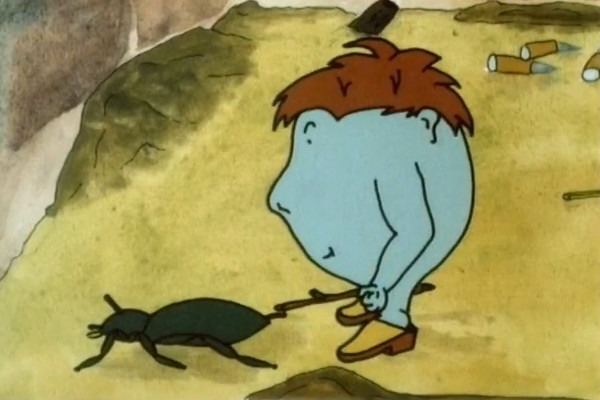
Murun's lack of hygiene seems to be played up more in this first series, and here, finding a beetle in his house that he can't get rid of, he decides to put a cover on it and use it as a table. As this charming scene also features three disused fag ends (or cigarette ends if you're outside the UK), it's a particularly repugnant low from Murun. Though Murun missing the beetle after it's gone is a nice bit of reflective poignancy, a characteristic trait of the programme.
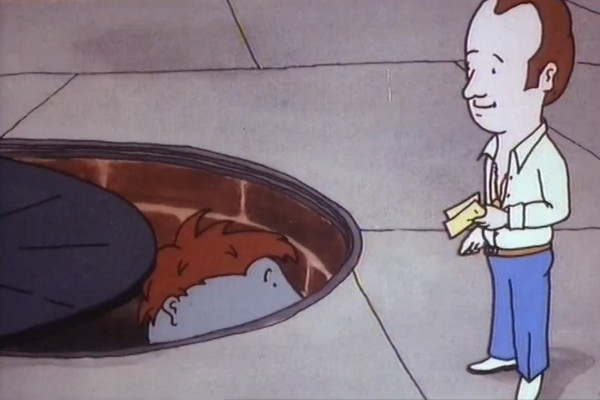
Murun was shown in a very different time for Channel 4. This particular episode aired in a double bill with episode 7 on the 20th November 1983, going out at 9:45pm after an edition of access programme People to People. A time when Channel 4 would screen experimental short films like John Smith's The Black Tower, or broadcast an uninterrupted 80 minutes of ultramarine picture with Derek Jarman's Blue.
It was certainly a niche platform, and, while its film output is still respected, the Sunday night schedule at date of writing is very different - October 2020 sees it filled by Gogglebox, The Great British Bake Off, repeats of The Simpsons and a Transformers movie. No room there for a Bach concert or an edition of The World At War, things which 1983 Channel 4 viewers were treated to... whether they liked it or not.
This very "pre-90s" feel comes to the fore here, when Nigel Clarke gets tickets to a concert at the local "polytechnic". Although Murun is shown in other episodes to live in the fictitious town of Mayford, such an institution would of course no longer exist. As Murun had planned to take his neighbour out on the same evening, it all ends with Murun once again alone, and filled with regret.
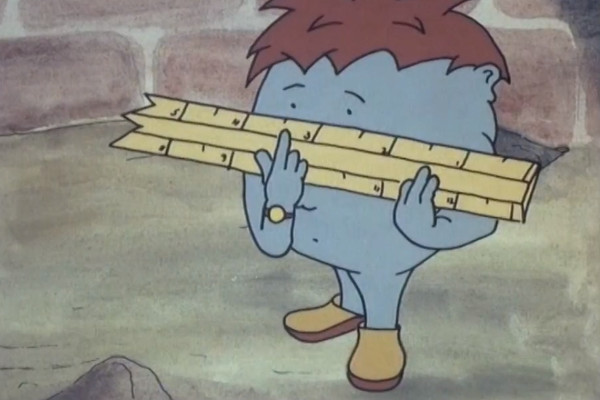
Another way in which Murun would struggle in the current TV landscape is just how short it is. Only one episode from this first series (the twelfth) manages to go past four and a half minutes, while this particular instalment doesn't even reach four. The opening and closing titles last almost a minute (okay, 59 seconds precisely) combined, which may not sound like much, but when this particular episode only lasts 3'34m, we're talking about 28% of the entire programme.
Away from such anal minutiae (this is the Anorak Zone, after all) then this is quite a cute tale of Murun's insecurities, with his fixation that his eyes are too close together. It's likeable, and has a nice ending, although it's perhaps lighter in tone and content compared to some of the other entries.
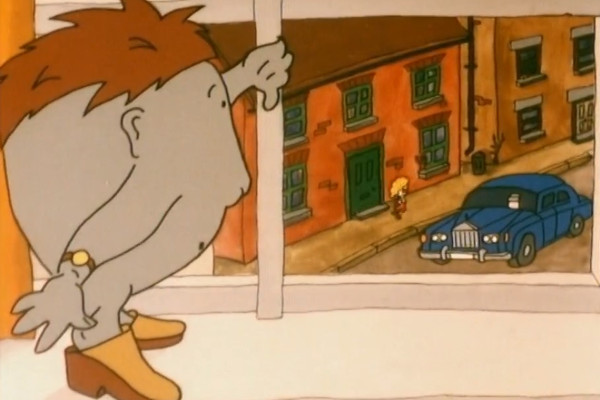
The very first episode of Murun Buchstansangur, and one which has the quite insightful observation that our love and attraction towards others often only lasts when it's not returned. Though there is a "pilot episode" feel to events, as it ends with the conclusion that, for Murun, "the magic was gone forever", something which quickly had to be reversed in order to continue the drama in the following weeks.
This "pilot episode" feel extends to the animation, which, while incredibly limited in movement, does seem to have more motion than normal, and far more camera pans than the average instalment. No one ever mistook Murun Buchstansangur for cutting-edge anime - indeed, the incredibly primitive animation "style" is one of its main charms - but whereas a lot of Murun would adopt the Filmation-style template of minimal movement and repeated frames of action, for this opener a bit more effort has been put in.
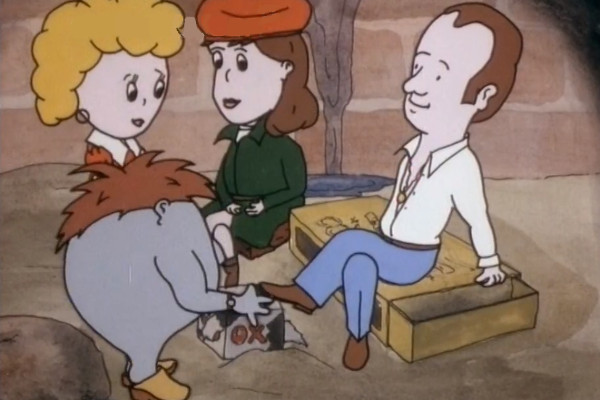
One of the more existential episodes, as Murun suffers badly from a migraine and encourages three friends to go to a remote pub without him, before being unsure whether the pub actually exists. Even despite his migraine, Murun's anti-social tendencies can be gleaned here, whereby he hates being brought into conversations, and decides to leave his friends to their own devices and go to sleep instead.
A slight episode even by the incident-light standards of the series, what causes this one to rank so highly is the innate depression at the heart of the main character. Murun Buchstansangur isn't an uplifting series, and many of his problems are self-imposed. This particular episode went out as a double bill with episode ten, airing at 9:55pm after forgotten political satire Struggle, an episode of People To People and a film about the Rothschild dynasty. It didn't seem out of place.
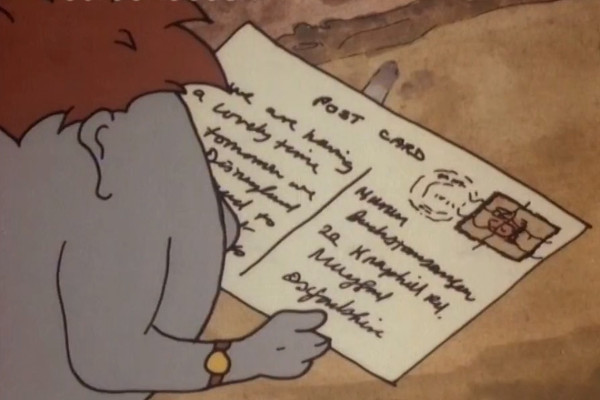
Behind every great episode of Murun Buchstansangur there's a uneasy feeling of lingering dread. Although broadcast of episodes 4-13 were held back until the following year, they were the product of 1982. A miner's strike and a new Cold War were just around the corner, and Murun seemed the ideal personification of an England that went to war with Argentina, had three million unemployed citizens, and was still suffering mainland attacks by the IRA.
The same year that Murun was created was also the same year that the band The Smiths formed - a group whose music you'd put on to lighten the mood after spending time with Murun. This one is a single-hander, where the only other creature seen is a dying fly that Murun keeps around as decoration. He puts it away and tidies up after receiving a postcard from his neighbour telling him she's on her way back home from a holiday. As her flight back eventually gets delayed, Murun returns to his depressive state, left with the thought that "the more you look forward to something, the more likely you are to be disappointed".
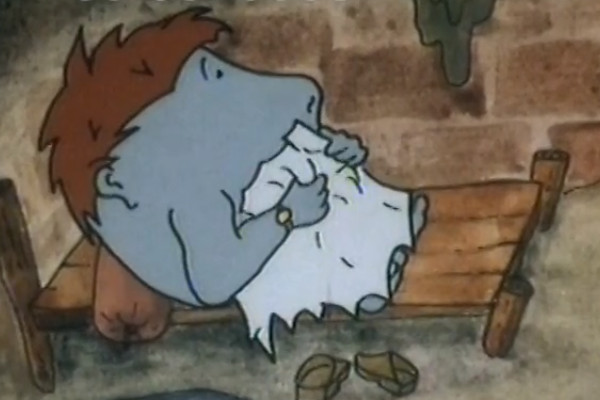
With so many cartoons aimed at adults in the current age, there's a very real acceptance of the art form as being for different generations. A lot of this could perhaps be traced back to the debut of The Simpsons, which famously began as part of the post-watershed sketch programme The Tracey Ullman Show.
It's not that The Simpsons was the first cartoon aimed at adults, with many pre-Code cartoons pushing boundaries, and the X-Rated Fritz The Cat going out to cinemas in 1972. But during the 1990s, the popularity of cartoons aimed at an older audience and the increasing diversity of channels has led to the current era where grown men and women watching animated comedies is a regular part of adult life.
The early 1980s weren't quite the same place. The only Marvel Comic movies released during Murun's lifespan were the derided Howard The Duck and a straight-to-video production of The Punisher. In this environment it seemed that the schedulers weren't quite clear what to do with the programme, and even today viewers of the show are sometimes unsure exactly who the target audience was.
It was bounced around the watershed during its second and third series, often being used as the "schedule filler" it's often cited as, before the fourth series debuted in 1989 at an inexplicable 9:25am slot for children. Considering the later episodes saw Murun sleep with his neighbour and begin to drink frequently, it does raise the question of whether anyone at Channel 4 actually watched the episodes before they went out.
All of which brings us to this instalment, where, despite his neighbour's varied problems, Murun can't stop obsessing about a small piece of navy blue raincoat lining which reminds him of his childhood. Murun had clearly been suffering from depression before this instalment - he spends a week in bed, upset, in just the second episode - but this is the first time that depression is actually directly referred to by name. Although creator Timothy Forder regarded it as an "all ages" kind of programme, it clearly wasn't... a desolate, bleak show where the distressed lead character stares into the abyss, and the abyss doesn't so much stare back as turn away out of discomfort.